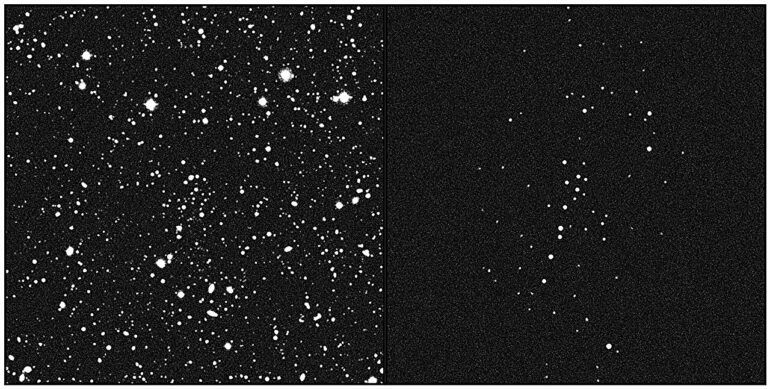A team of astronomers led by the University of Victoria and Yale University has detected an ancient star system traveling around our galaxy named Ursa Major III / UNIONS 1 (UMa3/U1)—the faintest and lowest-mass Milky Way satellite ever discovered, and possibly one of the most dark matter-dominated systems known.
The team conducted the study from Hawaiʻi using two Maunakea Observatories on Hawaiʻi Island—W. M. Keck Observatory and Canada-France-Hawaiʻi Telescope (CFHT)—as well as the University of Hawaiʻi Institute for Astronomy Pan-STARRS (Panoramic Survey Telescope and Rapid Response System) on Haleakalā, Maui; the findings are published in a recent edition of The Astrophysical Journal.
“UMa3/U1 is located in the Ursa Major (Great Bear) constellation, home of the Big Dipper. It is in our cosmic backyard, relatively speaking, at about 30,000 light-years from the sun,” says Simon Smith, an astronomy graduate student at the University of Victoria and lead author of the study. “UMa3/U1 had escaped detection until now due to its extremely low luminosity.”
Observations reveal the stellar system is tiny, with only about 60 stars that are over 10 billion years old, spanning just 10 light-years across. UMa3/U1 has an extremely low mass—at 16 times the mass of the sun, it is 15 times less massive than the faintest suspected dwarf galaxy.
UMa3/U1 was first detected using data obtained from the Ultraviolet Near Infrared Optical Northern Survey (UNIONS) at CFHT and Pan-STARRS.
The team then studied the star system in finer detail using Keck Observatory’s Deep Imaging Multi-Object Spectrograph (DEIMOS) and confirmed UMa3/U1 is a gravitationally-bound system, either a dwarf galaxy or a star cluster.
“There are so few stars in UMa3/U1 that one might reasonably question whether it’s just a chance grouping of similar stars. Keck was critical in showing this is not the case,” says co-author Marla Geha, professor of astronomy and physics at Yale University. “Our DEIMOS measurements clearly show all the stars are moving through space at very similar velocities and appear to share similar chemistries.”
“Excitingly, a tentative spread in velocities among the stars in the system may support the conclusion that UMa3/U1 is a dark matter-dominated galaxy—a tantalizing possibility we hope to scrutinize with more Keck observations,” says Yale University graduate student Will Cerny, the second author of the study.
How these stars have managed to stay a tight-knit group is remarkable. One possible explanation is that dark matter may be keeping them together.
“The object is so puny that its long-term survival is very surprising. One might have expected the harsh tidal forces from the Milky Way’s disk to have ripped the system apart by now, leaving no observable remnant,” says Cerny. “The fact that the system appears intact leads to two equally interesting possibilities. Either UMa3/U1 is a tiny galaxy stabilized by large amounts of dark matter, or it’s a star cluster we’ve observed at a very special time before its imminent demise.”
With the former scenario, achieving direct confirmation of UMa3/U1 as a faint, ancient, dark matter-dominated satellite star system would be an exciting feat because it would support a prediction in the leading theory for the universe’s origin.
Under the Lambda Cold Dark Matter (LCDM) model, scientists hypothesize that when galaxies like the Milky Way first formed, they created a gravitational pull during their assembly process that attracted hundreds of satellite star systems that continue to orbit galaxies today.
A companion study on UMa3/U1’s implications on the LCDM theory has been accepted for publication in The Astrophysical Journal and is available in preprint format on the arXiv server.
“Whether future observations confirm or reject that this system contains a large amount of dark matter, we’re very excited by the possibility that this object could be the tip of the iceberg—that it could be the first example of a new class of extremely faint stellar systems that have eluded detection until now,” says Cerny.
Conclusive evidence of the presence or lack of dark matter in UMa3/U1 is key to determining whether the star system is a dwarf galaxy or a star cluster. Until its classification becomes clear, Ursa Major III / UNIONS 1 has two names. Ultra-faint Milky Way satellites are typically named after the constellation they are discovered in (in this case, Ursa Major), whereas ultra-faint star clusters are generally named after the survey project they were discovered in (UNIONS).
While this star system’s identity is still ambiguous, UMa3/U1 paves the way for new perspectives in cosmology.
“This discovery may challenge our understanding of galaxy formation and perhaps even the definition of a ‘galaxy’,” says Smith.
More information:
Simon E. T. Smith et al, The Discovery of the Faintest Known Milky Way Satellite Using UNIONS, The Astrophysical Journal (2024). DOI: 10.3847/1538-4357/ad0d9f Raphaël
Errani et al, Ursa Major III/UNIONS 1: the darkest galaxy ever discovered?, arXiv (2023). DOI: 10.48550/arxiv.2311.10134
Provided by
W. M. Keck Observatory
Citation:
Faintest known star system orbiting the Milky Way discovered (2024, March 28)



